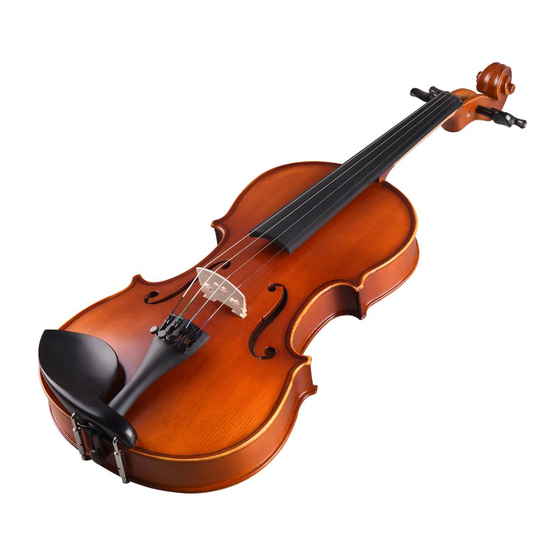
Summary of Contents for Pyle PGVILN100
-
Page 2: Getting Started
First time players will achieve the best results by bringing the violin to a music teacher to assist with the initial assembly. Please read through the manual below to familiarize yourself with your new instrument. If damaged goods are found, the wrong item was received, an exchange or refund in required, please email your seller immediately. -
Page 3: Sound Post
3. PEGS: The pegs can be shrink or expand due to the temperature and humidity changes. When the peg shrink, it will not t the peg hole as well as they were originally made. It will leave a little gap between the peg and peg hole. This is why the strings slip. Simply apply the rosin powder or peg drop oil (which you can get from the retail store) on the pegs and peg hole. - Page 4 If the bridge is too tight and will not budge, you can loosen one or two strings to provide more give. Do not loosen all of the strings as that will cause the bridge to fall over! Continue making very slight and small adjustments to the bridge until it is back in line.
- Page 5 Step 3 Remove the bridge gently from the violin. Step 4 Mark the New bridge: Use a pencil or other marking tool to add 4 light marks where the 4 strings sit on the top of the new bridge. • The width should be wide enough so that when you are playing on only one string the bow won't produce noise from adjacent strings.
- Page 6 Step 6 Hold the bridge in one hand and tighten the strings in the reverse order you loosened them. That is, tighten the A-string and D-string rst, and then, tighten the E-string and G-string. Tighten until each string matches its rough standard pitch (violin tuner suggested). •...
- Page 7 How to Tune Your Violin How to Tune a Violin with a Tuner 1. Switch the tuner ON. 2. Pluck the violin’s G string. 3. Watch the gauge on the tuner, where you see a little needle moving around. The needle registers the pitch and tells you if your note is too low or too high.
- Page 8 If you can’t get the string perfectly in tune, that’s okay. Just get it as close as you can. For the rest of the pegs, you’ll use the same process, except when you go to tune the G and the D strings you’ll switch hands and use your left hand to turn and your right hand to pluck and support.
- Page 9 Features: What's in the Box: • High-Quality Piano Code • Violin • Wood Grain Visible • Extra Set of String • Double F Control Uniform Symmetry • Tuner • Set Up and Ready to Play • Shoulder Rest • Lightweight and Smooth Finish •...
- Page 10 Questions? Comments? We are here to help! Phone: (1) 718-535-1800 Email: support@pyleusa.com...




